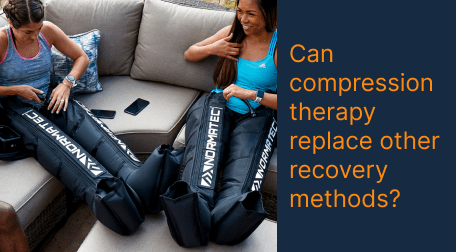compression therapy

In the pursuit of faster and more efficient recovery, athletes and fitness enthusiasts are increasingly turning to alternative methods. One such method that has gained popularity is compression therapy. This article explores the question: Can compression therapy replace other recovery methods?
Understanding Compression Therapy:
Compression therapy involves using specially designed garments to apply controlled pressure to specific body areas, enhancing blood circulation and promoting a speedier recovery. While it has demonstrated effectiveness in various scenarios, understanding its role in comparison to traditional recovery methods is crucial.
Benefits of Compression Therapy:
Enhanced Blood Flow: Compression garments boost blood circulation, delivering vital nutrients and oxygen to muscles for faster recovery.
Reduced Swelling: The pressure exerted helps minimize post-exercise or injury swelling, contributing to a quicker healing process.
Muscle Support: Compression sleeves provide targeted support to muscles and joints, reducing the risk of injuries and promoting stability.
Lactic Acid Removal: By aiding in the elimination of lactic acid buildup, compression therapy helps alleviate muscle soreness.
Can compression therapy stand alone?
While compression therapy offers a range of benefits, it is essential to recognize its role as a complementary rather than a replacement method for traditional recovery strategies. Here’s why:
Holistic Recovery: Optimal recovery involves a holistic approach, combining various methods such as rest, hydration, nutrition, and targeted exercises.
Individual Variances: The effectiveness of recovery methods varies among individuals. What works for one person may not be as effective for another.
FAQs: Addressing Common Concerns:
Q1: Is compression therapy suitable for everyone?
Yes, compression therapy is versatile and can benefit athletes, individuals recovering from injuries, and those managing chronic conditions.
Q2: Can compression therapy completely replace rest days?
No, rest days are crucial for overall recovery. Compression therapy should be seen as a supplementary measure to optimize the recovery process.
Q3: How long should one wear compression garments for optimal results?
The duration varies based on individual needs and the purpose of therapy. Consultation with a healthcare professional can help determine an appropriate schedule.
Conclusion:
In conclusion, while compression therapy offers a promising avenue for enhanced recovery, it cannot entirely replace traditional methods. The key lies in finding a balance and integrating compression therapy into a broader recovery strategy. Combining rest, hydration, nutrition, and targeted exercises ensures a comprehensive approach to recovery.
